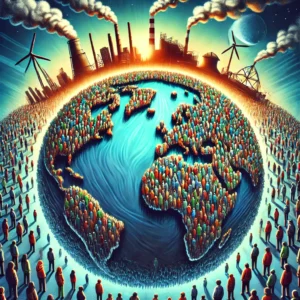Climate change, pollution, and global warming are undoubtedly the most critical challenges facing humanity today. At the heart of these crises lies the root cause of climate change: overpopulation. With a rapidly growing global population, demand for resources has surged, leading to overconsumption and a chain reaction of environmental consequences. Overconsumption drives industrialization, which in turn fuels the very crises we’re trying to combat.

The Overpopulation Domino Effect
Overpopulation amplifies the strain on Earth’s finite resources. As the number of people increases, so does the demand for essentials like food, water, energy, and consumer goods. This escalating demand pushes production and manufacturing to unsustainable levels, resulting in heightened industrial activity—a major contributor to climate change and environmental degradation.
Key Impacts of Overpopulation:
- Deforestation: To meet agricultural and urban development needs, forests are cleared at alarming rates, leading to habitat destruction, loss of biodiversity, and increased carbon emissions.
- Pollution: More people generate more waste, including plastics, chemicals, and air pollutants that harm ecosystems and human health.
- Energy Crisis: Rising energy demand leads to increased reliance on fossil fuels, which are the primary drivers of greenhouse gas emissions.
- Water Stress: Overpopulation strains freshwater supplies, exacerbating water scarcity in many regions.
The Role of the Replacement Rate in Population Stability
The replacement rate is the average number of children a woman must have to maintain a stable population. Globally, this rate is 2.1 children per woman, but what is ideal can vary based on a country’s socio-economic context:
- In Developed Countries
- Ideal Rate: Around 2.1 or slightly below.
- Reason: With slower population growth, advanced healthcare systems, and higher life expectancy, developed nations benefit from maintaining replacement-level fertility to ensure demographic and economic stability.
- In Developing Countries
- Ideal Rate: Slightly above 2.1 (around 2.3–2.5).
- Reason: Higher child mortality and lower life expectancy necessitate a slightly higher fertility rate to sustain a stable workforce and support economic development.
- For Aging Populations
- Ideal Rate: Higher than 2.1, depending on the extent of population aging.
- Reason: Nations like Japan and Italy face aging populations and shrinking workforces. A higher fertility rate can help rebalance demographics and alleviate economic strain.
Rethinking the Ideal Global Population
Defining an ideal global population involves complex considerations, including resource availability, consumption patterns, and technological advancements. Many experts agree that Earth’s long-term sustainability would be better supported with a population between 1–3 billion, provided resources are equitably distributed and consumption patterns are sustainable. Here’s why:
Factors Influencing the Ideal Population
- Resource Availability
- Land: Out of Earth’s 12 billion hectares of habitable land, only 1.6 billion hectares are suitable for agriculture.
- Freshwater: Renewable freshwater resources are finite and unevenly distributed globally.
- Energy: Transitioning from fossil fuels to renewable energy can only support fewer people sustainably.
- Ecological Footprint
- Earth’s biocapacity (ability to regenerate resources and absorb waste) supports about 1.8 global hectares per person.
- Currently, humanity consumes 2.8 global hectares per person, far exceeding what the planet can sustain.
- Standard of Living
- A higher standard of living demands more resources per person. Reducing population can help balance equitable resource distribution.
- Technological Innovations
- Advances in agriculture, water conservation, and renewable energy can potentially increase Earth’s carrying capacity, but only to a limited extent.
Population Projections:
- 1–2 billion: Sustainable for global high living standards without depleting resources (E.O. Wilson’s estimate).
- 3–4 billion: Feasible with moderate resource use and improved efficiency.
- 7–8 billion: Requires drastic changes in resource allocation, conservation efforts, and technological breakthroughs (current global population as of 2025).
Why Overpopulation is the Root Cause of Climate Change
Overpopulation intensifies nearly every environmental issue:
- Climate Change: More people mean higher greenhouse gas emissions from transportation, industrial activity, and energy use.
- Biodiversity Loss: Expanding urban and agricultural areas destroy habitats and threaten species.
- Resource Depletion: Increased consumption strains essential resources like freshwater and arable land.
- Waste Management Crisis: Growing populations generate overwhelming amounts of waste, far outpacing recycling and disposal systems.
Conclusion: Addressing Root Cause of Climate Change for a Sustainable Future
While Earth’s resources may temporarily support the current population of 8 billion, it comes at the cost of severe environmental degradation and inequality. A sustainable population—estimated between 1–3 billion—would allow for equitable resource distribution, higher living standards, and reduced ecological stress. Tackling overpopulation through education, family planning, and sustainable policies is crucial for mitigating the root cause of climate change and preserving the planet for future generations.
By addressing overpopulation, we can break the cycle of overconsumption and industrialization, paving the way for a healthier and more sustainable Earth.
You may also find interest in reading this –Industrial Hygiene: A Comprehensive Guide to Safeguarding Workplace Health and Safety


